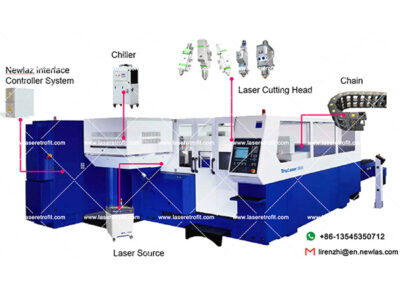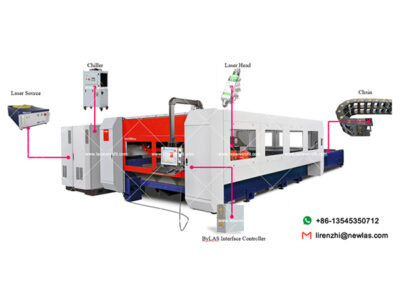Is there a most effective way to cut through a steel plate? The easy answer is: It depends. You have to factor in the application, speed required, and thickness of the steel plate or sheet metal you are cutting. Once you’ve considered these, you can choose from one of the four methods for cutting steel plate on a CNC machine.
Four Methods
Oxy-Fuel Cutting
Oxy-fuel torch cutting, or flame cutting, is the oldest method for cutting mild steel. It is generally a simple process, and the equipment and consumables are relatively inexpensive.
An oxy-fuel torch can cut very thick steel plate and is limited primarily by the amount of oxygen that can be delivered. The oxy-fuel cutting method will allow you to cut through anywhere from 36 to 48 inches of steel. However, when it comes to shape cutting from steel plate, the majority of work is done on a 12-inch plate or thinner.
Oxy-fuel cutting is also a good option for plates thicker than 1 inch but can be used all the way down to a 1/4 inch thick plate. It is a relatively slow process, topping out at around 20 inches per minute on a 1-inch material. However, you can easily integrate multiple torches at once, increasing your productivity.
When adjusted properly, an oxy-fuel torch delivers a smooth, straight-cut metal surface. There’s a little slag on the bottom edge and the top edge is only slightly rounded from the preheat flames. This surface is ideally suited for applications without further treatment.
Plasma Arc Cutting
Plasma arc cutting is another excellent method for cutting mild steel plate. Plasma cutting offers much higher speeds than oxy-fuel, although you will sacrifice some edge quality, as a result.
The optimal range for edge quality is between 1/4 inch up to 1.5 inches. Overall edge quality begins to decrease when the plate is outside that range, even though the edge smoothness and dross performance are still good.
Plasma equipment can be expensive when compared to an oxy-fuel torch. A complete system requires a power supply, water cooler (on systems over approximately 100 amps), a gas control, torch leads, interconnecting hoses, and cables, and the torch itself. Depending on your application, the increased productivity may be worth the additional cost.
You can also cut with more than one plasma torch at once. However, this is often not as cost-effective depending on the volume of steel plate cuts.
Waterjet Cutting
Waterjet cutting is another good choice for cutting mild steel, ensuring a smooth and accurate cut. Accuracy can exceed that of laser cutting because of better edge smoothness without heat distortion.
Also, waterjet is not limited in thickness. The practical limit on waterjet cutting is around 6 to 8 inches, due to the length of time to cut that thickness and the tendency of the water stream to diverge.
Waterjet cutting lends itself to cutting with multiple heads and can even be done with a single intensifier pump. But each additional cutting head requires additional water flow with a larger pump or a smaller orifice.
One drawback to waterjet cutting is cost. Upfront equipment costs are usually a little higher than plasma due to the intensifier pump, but lower than laser. However, the cost-per-hour to run a waterjet is much higher because of the garnet abrasive that goes into the cut.
Laser Cutting
Laser cutting works best for cutting mild steel from about 1.25 inches. Beyond the 1-inch barrier, everything has to be precise to make it work reliably, including the material (laser grade steel), gas purity, nozzle condition, and beam quality.
Laser cutting is also extremely accurate. It creates a narrow kerf width and can therefore offer very precise contours and accurate small holes. Edge quality is excellent with extremely small serrations and lag lines; sharp, square edges; and little-to-no dross.
Laser cutting is also extremely reliable. The consumable life is long and machine automation very good, so that many laser cutting operations can be done “lights-out.”
This means you can load a 10’ x 40’ plate of 1/2” steel on the table, press the “Start” button, and go home for the evening. In the morning, you’ll have hundreds of parts cut and ready to unload.
Four steps to choose best way to cut stainless steel plate
So how do you choose the best way to cut steel plate for your application? Consider the following factors.
1. Thickness
- Use laser for steel thinner than 0.080”.
- Use plasma or laser for steel thinner than 0.125”.
- Use waterjet, plasma, or laser for steel thinner than 0.250”.
- Use oxy-fuel if it’s over 8”.
- Use oxy-fuel or waterjet if it’s over 2”.
- Use plasma, oxy-fuel, or waterjet if it’s over 1.25”.
2. Accuracy & Edge Quality
- Most fabrications from steel plate can be welded using a plasma cut; however, the edge quality might be lower.
- If you can’t accept the Heat Affect Zone of oxy-fuel, plasma, or laser, then use waterjet.
3. Productivity vs. Cost
- If production rate is most important, avoid waterjet.
- If low initial investment and low operating cost are most important, oxy-fuel is the answer.
4. Additional Considerations
- Can you tolerate occasional dross on the bottom of the plate? If not, use waterjet or laser.
- Do secondary operations require perfectly round holes? If so, use a waterjet or laser.
Fiber laser cutting is still in rapid development, it’s with higher cutting speed and cutting effeciency, cutting thickness is also increasing. If you are a owner of CO2 laser cutting machine and interested in fiber laser cutting to do your business, we are glad to introduce our Bystronic & Trumpf CO2 retrofit solution, which can upgrade your CO2 machine to fiber laser within short time and improve your production efficiency.






